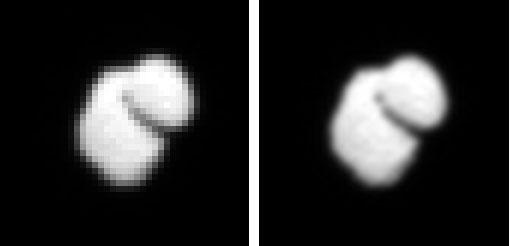| Jul 17, 2014 |
The twofold comet
|
|
(Nanowerk News) As ESA’s spacecraft Rosetta is slowly approaching its destination, comet 67P/Churyumov-Gerasimenko is again proving to be full of surprises. New images obtained by OSIRIS, the onboard scientific imaging system, confirm the body’s peculiar shape that earlier pictures had hinted at. 67P is obviously quite unlike any other comet visited so far.
|
 |
| An image of comet 67P/Churyumov-Gerasimenko (left) obtained on July 14th, 2014 and the corresponding interpolated data (right). The left image was taken by OSIRIS, the mission’s onboard scientific imaging system, from a distance of approximately 12000 kilometres. (Image: ESA/Rosetta/MPS for OSIRIS Team MPS/UPD/LAM/IAA/SSO/INTA/UPM/DASP/IDA)
|
|
“The distance still separating Rosetta from 67P is now far from astronomical”, says OSIRIS Principal Investigator Holger Sierks from the Max Planck Institute for Solar System Research (MPS) in Germany. “It’s a trip of less than 14000 kilometers. That’s comparable to travelling from Germany to Hawaii on a summer holiday.”
|
|
However, while taking a snapshot of the Mauna Kea, Hawaii’s highest mountain, from Germany is an impossible feat, Rosetta’s camera OSIRIS is doing a great job at catching ever clearer glimpses of its similarly sized destination. Images obtained on July 14th clearly show a tantalizing shape. The comet’s nucleus consists of two distinctly separated parts.
|
|
“This is unlike any other comet we have ever seen before”, says OSIRIS project manager Carsten Güttler from the MPS. “The images faintly remind me of a rubber ducky with a body and a head”, he adds with a laugh. How 67P received this duck-like shape is still unclear. “At this point we know too little about 67P to allow for more than an educated guess“, says Sierks. In the next months, the scientists hope to determine more of the comet’s physical and mineralogical properties. These could help decide, whether the comet’s body and head were formerly two individual bodies.
|
|
In order to get an idea of what seems to be a very unique body, the observed image data can be interpolated to create a smoother shape. “There is, of course, still uncertainty in these processed, filtered images and the surface will not be as smooth as it now appears”, Güttler points out. “But they help us the get a first idea.”
|
|
Rosetta is an ESA mission with contributions from its member states and NASA. Rosetta's Philae lander is provided by a consortium led by DLR, MPS, CNES and ASI. Rosetta will be the first mission in history to rendezvous with a comet, escort it as it orbits the Sun, and deploy a lander to its surface.
|

